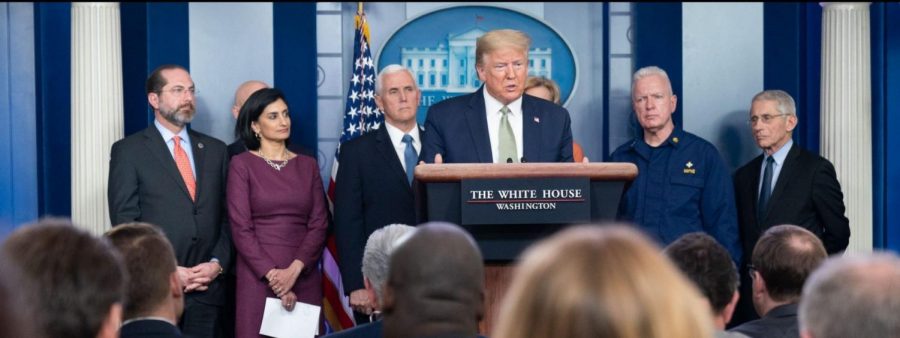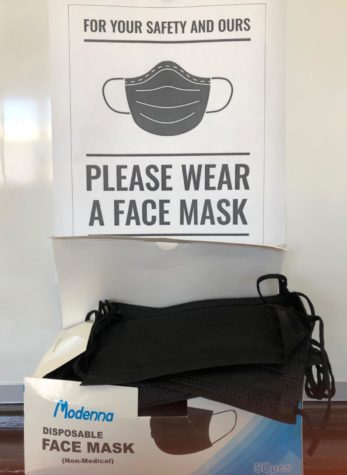Trump declares national emergency in response to COVID-19 pandemic
President Trump updates the public on the status of COVID-19 in the U.S.
March 25, 2020
On Friday, March 13, 2020, President Donald Trump declared a national emergency to deal with the coronavirus (COVID-19) outbreak. Referring to the national emergency as “two very big words,” the decision gives Trump access to $50 billion worth of funds to fight the virus.
Adam Kolokotrones ’20, a student in the AP Government class at Riordan, stated, “The national emergency lets the President impose more limits on citizens’ lives, frees up emergency funding transfers, and allows for certain military actions.”
According to AP Government teacher Jeff Isola ’98, the President “has over 130 ‘powers’ under a state of national emergency, ranging from halting communications to seizing bank accounts.”
In addition, President Trump’s powers for duration of the coronavirus epidemic specifically may include, “forcing manufacturers to produce ventilators, pharmaceutical companies to dedicate all resources to producing anti-virals or studying vaccines, mandating hospital policies, even (as we’ve seen) using the military,” said Isola.
President Trump can resort to martial law if the situation gets too out of control. In other words, if the coronavirus spreads to too many individuals within the United States, regular civil life will be replaced by temporary military authority. However, martial law is only a last resort.
On Tuesday, March 17, California Governor Gavin Newsom announced that martial law would be imposed “if we feel the necessity.” Though it is unlikely this will happen, it is still a possibility should the situation escalate.
Even though states have the power to enact their own laws, federal authority still overrules the states’ powers. “California and New York, and especially their municipalities, have been much more proactive than other states, hopefully slowing the ‘curve’ we’ve all been hearing about,” said Isola.
“Whereas states like Florida, who have taken a more wait-and-see approach, may end up being detrimental to the country in the long haul, which is why it may be necessary for the federal government to take more aggressive actions.”
California and New York, two of the three states with the most COVID-19 cases in the U.S. as of March 24, have ramped up efforts to combat the spread of the disease. However, as Isola said, if other states fail to take immediate action, federal authority may step in at any time.
One of the problems that America faces in combating the disease is the amount of space in hospitals. Daniel Hipon ’20, another student in the AP Government class, stated that the federal government is in a dilemma “because hospitalization is a limited resource, and treating mild cases could be a waste of space.” He continued, “And since there isn’t an antiviral or vaccine, the best thing the federal government can do is provide financial assistance wherever necessary, and to keep the public informed.”
Despite the efforts of the federal government to prevent the spread of COVID-19, many individuals criticize President Trump’s actions during this pandemic. Hipon said, “…during the early stages of the breakout [Trump] was reassuring people that everything was fine.”
In reality, the disease was spreading rapidly across the United States.
“It was at this stage, when there were hardly any cases, that we should’ve jumped on it. These diseases spread exponentially, and it would have been easier to contain it if people began isolating earlier,” said Hipon.
Jovani Magana ’20, also a member of the AP Government class, stated, “It took Trump too long to realize how big the situation really was and by the time he did the cases were only getting bigger and bigger.”
Travel is also a huge deal, with people entering and leaving the United States on a daily basis. On Wed., March 11, President Trump enacted a travel ban on Europe. Travel to and from the U.S. is suspended from more than 20 European countries, including France, Germany, Italy, and Spain.
“Once the virus spread to Europe and beyond, we should have closed the borders completely, especially when the CDC announced that an outbreak in the U.S. was inevitable,” Kolokotrones said. “If we had taken more preemptive measures, we wouldn’t be fighting to contain an outbreak, we would have largely prevented one, and we wouldn’t have had to cancel all of our extra curricular events.”
Though COVID-19 will likely continue to spread before the rate of infections decreases, both federal and state governments are working tirelessly to prevent the issue from becoming worse.










